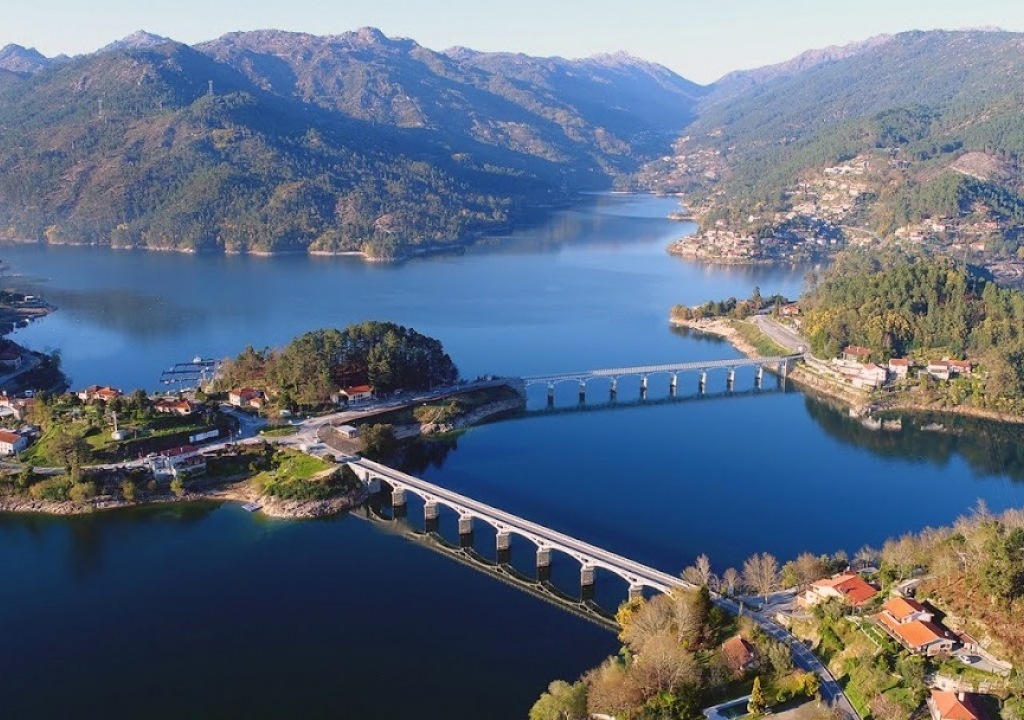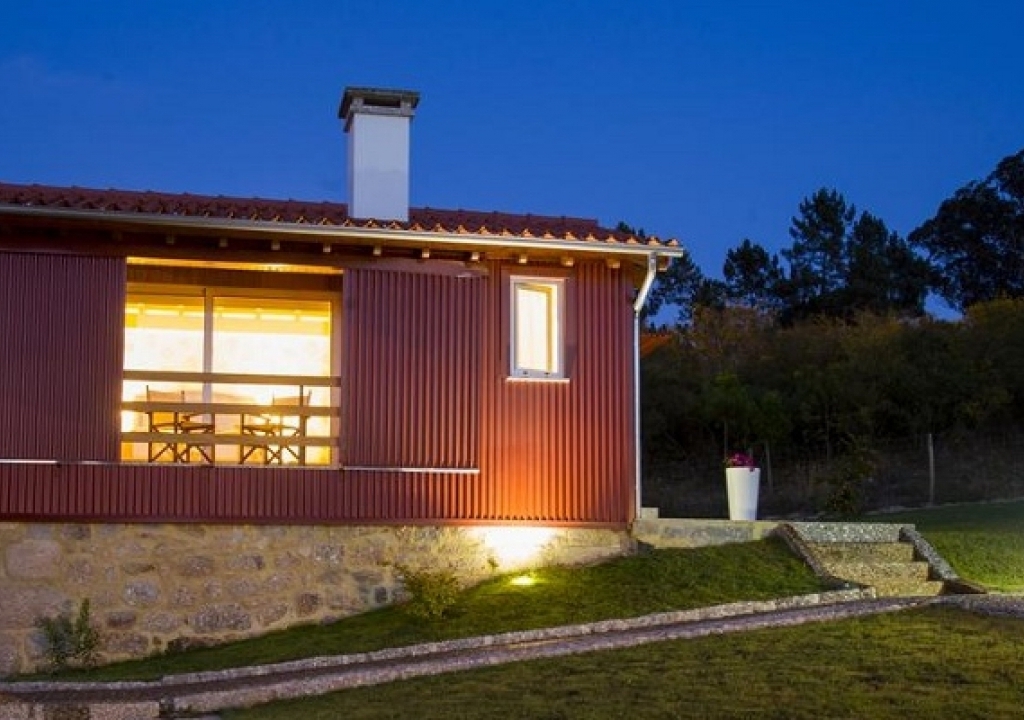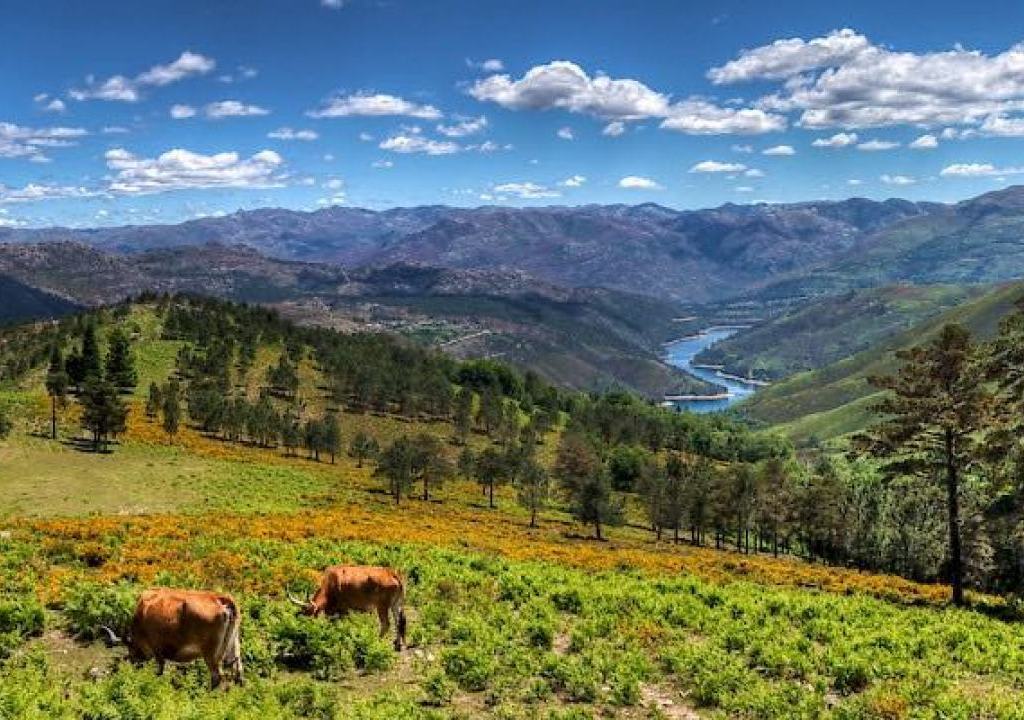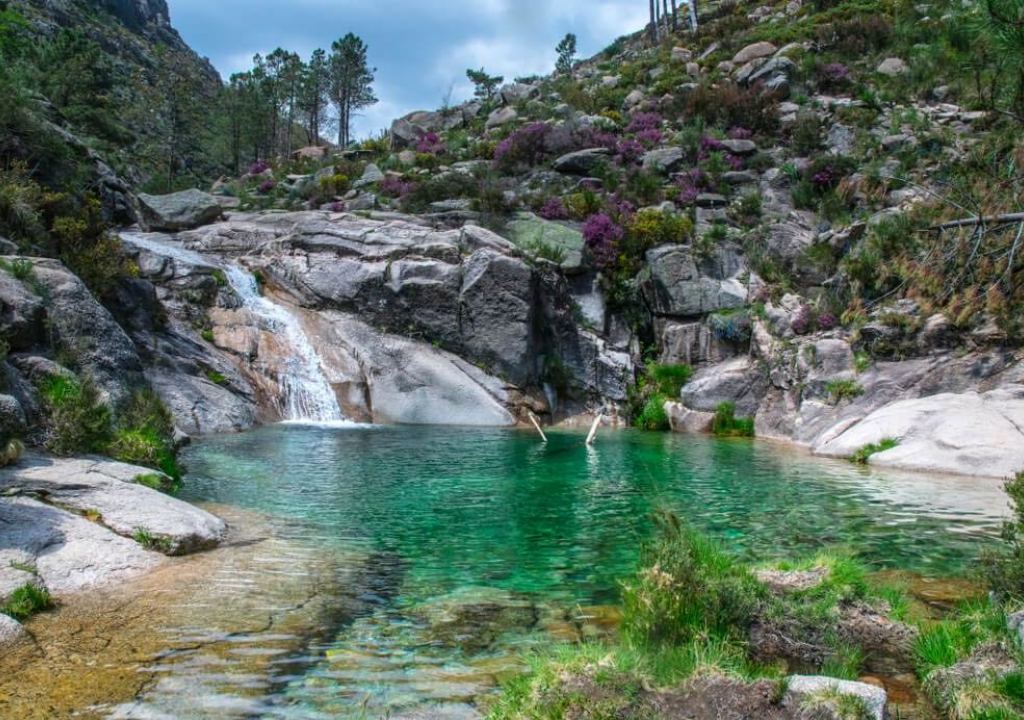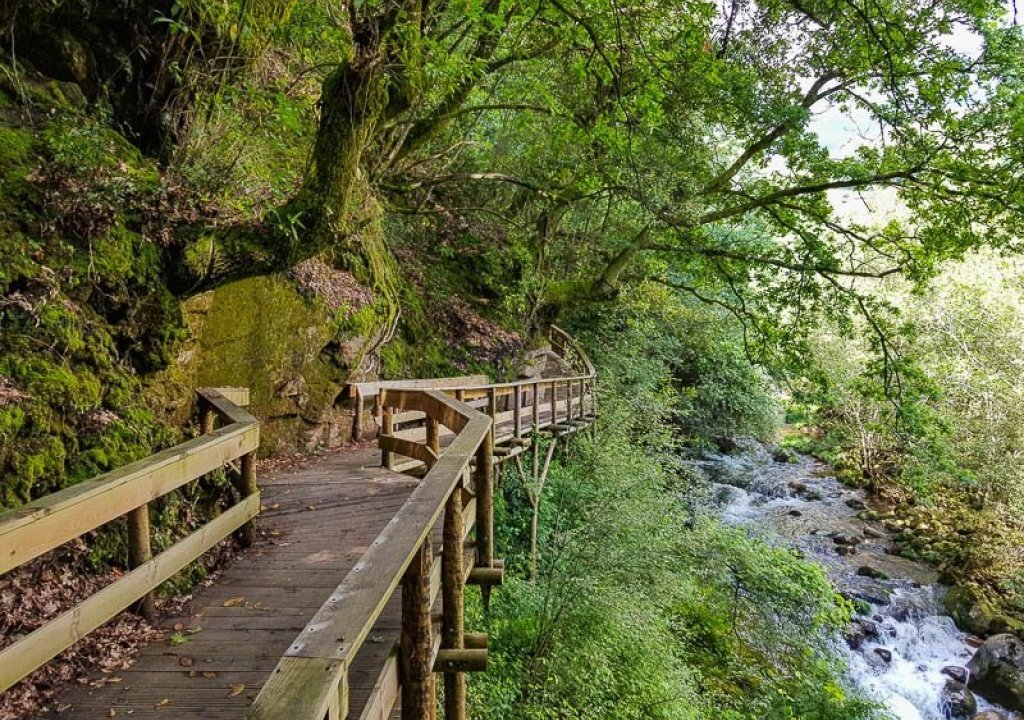Gerês - The Natural Reserve of Portugal!
Gerês, municipality of Terras de Bouro, has always symbolized the harmony between Man and Nature, in a permanent sharing of activities and feelings, of the people allied with Nature of the inhospitable granite mountains shaped by time. The waters run crystal clear along the streams and the fresh air involves the great diversity of fauna and flora providing a continuous movement of calm and pleasure.
The oldest villages are kept away from modern life. In these places, cows are still taken by women dressed in black through the streets and breeders let their animals graze for several months.
In the most isolated areas of the park there are still some wolves, wild boar, badgers, otters, deer and wild horses.
In addition to wild animals, domesticated species live here that are easier to observe, such as cows, goats and native sheep species, as well as the rustic Castro Laboreiro, a shepherd dog.
In addition to discovering the villages frozen in time, when visiting the Peneda-Gerês National Park you can also admire the magnificent landscapes, thanks to the numerous viewpoints, immerse yourself in the crystalline waters of its waterfalls, enjoy the various monuments with many centuries of history and even relax in a spa village!
To help you plan a visit to the Peneda Gerês National Park, we present you a compilation of places not to be missed, walking trails, gastronomy and accommodation.
The 5 gateway to Gerês
There are 5 entrance doors at Gerês, each dedicated to a theme. In all of them you can get a lot of valuable information to enjoy the best of Gerês.
- Porta de Mezio (Arcos de Valdevez): dedicated to the Conservation of Nature and Biodiversity
- Porta de Lamas de Mouro (Melgaço): dedicated to the History and Occupation of the Territory
- Montalegre Gate: dedicated to Landscape
- Porta do Lindoso (Ponte da Barca): Geology and Water
- São João do Campo Gate (Terras de Bouro): History and Civilizations
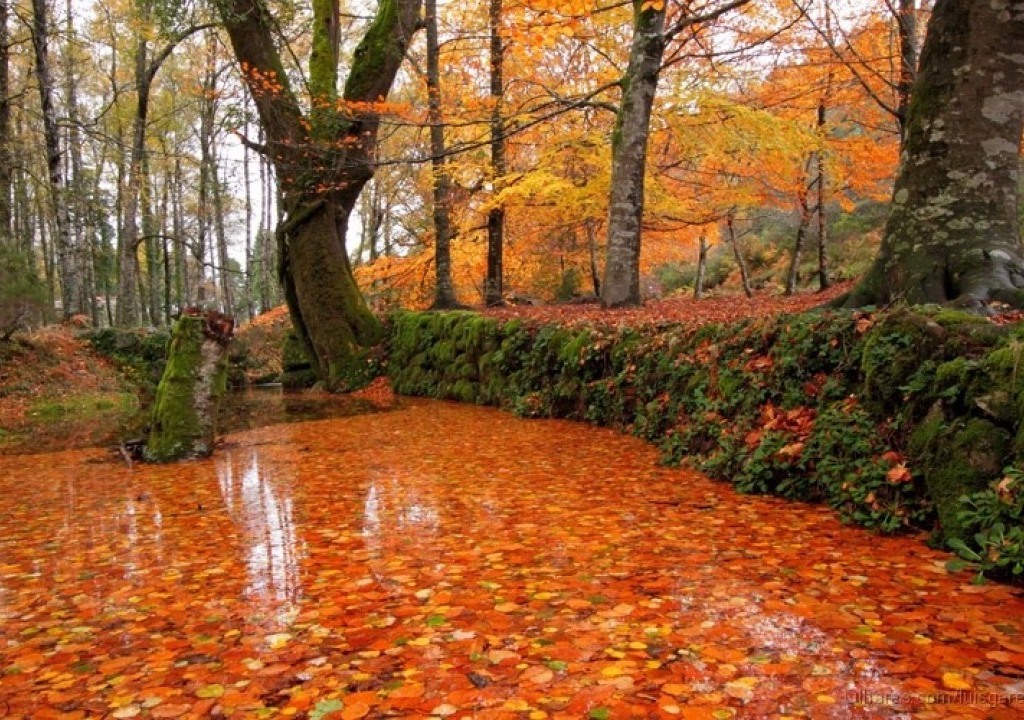
Winter, Autumn, Summer or Spring?
Any time is good to visit Gerês, depending also on the taste of each one.
The summer can be a little aggressive, especially on the mountain, due to the intense heat. The confusion is also greater and in any part of the National Park there are large groups of tourists, being difficult to park and find a vacant place in a restaurant to have lunch.
Winter is usually very harsh, not so much because of the snow, even because it gives excellent photographs, but the rain and especially the fog are discouraging and even potentially dangerous for those who do some walking in these conditions.
Therefore, perhaps autumn and spring are the ideal times to visit Gerês, so that you can enjoy all that it has to offer.

Accommodation
There are close to 500 accommodation units within the National Park, distributed by local accommodation, hotels, apartments and villas. There are also some campsites.
For a better search we leave you here this link where you can find everything about Gerês accommodation: https://www.topgeres.pt/

Places to visit
- Pitões das Júnias Village
One of the most typical villages of Montalegre, Pitões das Júnias stands out for its implantation next to Gerês and for the well-kept historic center. Be sure to try the local products, from meats to the famous Pitões bread.
- Pitões das Júnias Monastery
The origins of the Pitões das Júnias Monastery seem to date back to the 9th century, where it would function as a hermitage. Later, it passed to the Benedictine Order until its extinction in 1834. It is classified as a National Monument.
Travassos Boi Tower
This curious and unique monument located in the place of Travassos, represents the importance of the ox, as a symbol of Barroso and its strength mirrored in the countless victories that he obtained in the so-called "ox arrives".
- Albufeira de Paradela
Albufeira de Paradela is located on the edge of the national park, marking the end of the most rural territory and the beginning of the most inhospitable landscape. It was completed in 1956.
- Pedra Bela Viewpoint
This viewpoint is included in all tourist routes in the National Park. Don't miss the opportunity to enjoy a privileged view over the entire Gerês River valley to the Caniçada Dam.
- Albufeira da Caniçada
Whoever enters Gerês from the south side towards the spa town of Gerês, finds the huge body of water known as Albufeira da Caniçada. This dam divides the municipalities of Vieira do Minho and Terras de Bouro and was built in 1956. It is here that many tourists come together to practice water sports, such as jetski and canoeing.
- Vila do Gerês
The village of Gerês is well known for its thermal waters. This is where hotels and restaurants are concentrated.
- Portela do Homem
Portela do Homem is the border area with Spain and the crossing area of the famous Roman road known as Geira, which connected Bracara Augusta (Braga) to Asturica Augusta (Astorga).
- Mata da Albergaria
It is one of the most beautiful areas in the Park but also one of the most environmentally sensitive. Mata da Albergaria is a forest where oak and other species of great landscape and natural value predominate. Given the fragility of this ecosystem, your visit is conditioned, especially by car access.
- Minas dos Carris
This old mining complex, located at almost 1500m altitude, is truly fascinating. Not only for its implantation, in the top of the mountain, dominating a vast landscape that starts in Prado das Negras, but also for the economic dynamics that it created since its origin in the 40's, in the middle of the 2nd World War. The mines peaked during the 1950s, a time of great demand for wolfram, until their decline in the late 1970s.
- Vilarinho da Furna Albufeira
The Vilarinho da Furna Albufeira is located in Terras de Bouro and forms a beautiful mirror of water fed by the Homem River. Its construction in 1971 submerged the old community village of Vilarinho da Furna. When the water level is lower, it is possible to observe the ruins of the houses, walls and paths.
- Sanctuary of S. Bento da Porta Aberta
Sanctuary of S. Bentinho da Porta Aberta, is located in Rio Caldo, municipality of Terras de Bouro on the edge of the Peneda Gerês Park.
The history of this temple goes back to the middle of the century. XVII, where there was a chapel in this place that had a porch that always had open doors, serving as a shelter for those who passed by, thus originating the designation of S. Bentinho da Porta Aberta.
- Lindoso village
It is the castle and the magnificent set of granaries that make Lindoso, one of the best known villages in the North of Portugal. The granaries are concentrated around a single threshing floor, thus reflecting the importance of communitarianism, very typical of mountain villages.
- Lindoso Albufeira
It was in 1992 that the Alto Lindoso Dam was completed, an infrastructure that holds the waters of the Lima River. This system is one of the largest energy producers in Portugal and is located between the municipalities of Ponte da Barca and Arcos de Valdevez.
- Soajo Village
The village of Soajo is located in the southeastern part of the municipality of Arcos de Valdevez. The main points of interest to visit are the Pelourinho and the set of 24 granaries, built under a huge rock.
- Mezio
After passing through Soajo, you can visit the Mezio Megalithic Nucleus (an archaeological area consisting of several papayas, including the famous Mezio Tapir) and the Mezio Interpretation Center, which contains information about the cultural heritage and biodiversity of the region .
- Sanctuary of Senhora da Peneda
It is in a truly picturesque setting that the Peneda Sanctuary is found. This temple built during the 18th and 19th centuries, was implanted in the embedded valley of the Peneda River, where at its top stands the Fraga da Meadinha, a huge granite hill that defies the skill of climbing lovers.
Its design was inspired by the Bom Jesus de Braga Sanctuary where the similarity between churches and staircases is clearly visible.
Chã do Monte Swamp
Going up the Peneda Trail we find the Chã do Monte Swamp, which functioned as a mini-hydropower to produce energy for this region. It also allows you to visit Fraga da Meadinha. This is a good place to photograph the contrast between the water and the rocks.
- Peneda Valley Viewpoint
Viewpoint located on the road that connects Soajo to Gavieira and offers the traveler fabulous views over the Peneda Valley.
- Castro Laboreiro village
A stroll through the historic center is a good way to enjoy time in Castro Laboreiro. Go through the old streets and enjoy the core of houses built in stone.
- Castro Laboreiro Castle
Castro Laboreiro castle is classified as a National Monument, not only for its historical importance, but also for its visual impact. The origin of this fortification would have been contemporary with the reign of D, Afonso Henriques, in the context of defending the kingdom's borders. For centuries it suffered several attacks from the kingdoms of Leon and Castile, which is why it became necessary to strengthen and expand its line of walls.

Waterfalls
- Arado Waterfall
It is probably the most famous waterfall in Gerês and is located on the Rio Arado, parish of Vilar da Veiga, Terras de Bouro. This is one of the most visited places by tourists in the National Park, especially in spring and summer. If you like hiking, go up the hill and enjoy the landscape of the Teixeira Valley.
- Waterfall of Portela do Homem
Along the Homem River, several waterfalls are visible and the Portela do Homem waterfall is one of the most photogenic. In the heat of the season, there are many who refresh themselves here in these clear waters.
- Horses Waterfall
Located between the villages of Cela and Lapela, the Cascela de Cela Cavalos is a waterfall with a lagoon in Ribeira das Cavadas. This is a very peaceful place, ideal for relaxing. There are also some old windmills in the vicinity of the waterfall.
- Leonte Waterfall
The Leonte Waterfall is a waterfall located near Caldas do Gerês, parish of Vilar da Veiga. This waterfall is located 2 km from Portela do Homem next to the bridge and its waters come from the still incipient river Homem within the Peneda-Gerês National Park.
It forms with the fall of the waters from the top of a granite rock cliff. After the fall, the waters form a serene lagoon.
- Cascata de Fecha de Barjas
The Fecha de Barjas waterfalls, sometimes called Tahiti waterfalls, are a waterfall located in Caldas do Gerês, parish of Vilar da Veiga.
It is a high mountain waterfall whose waters come from the Arado River and which can only be reached by footpaths. This waterfall ends in a calm and serene lagoon with sandy banks and crystal clear waters that represent a refuge for the difficult path.
- Peneda Waterfall
Cascata da Peneda is a waterfall located in the Serra da Peneda, Peneda-Gerês National Park, parish of Gavieira. This waterfall is visible from a great distance due to the white foam that its waters make in the fall. The stream runs with fury and shrouded in loud noise, with a waterfall dropping 30 meters high.
- Blue Well
Affluent of the Vouga River, the Landeira stream is responsible for bathing this well with its waters of unparalleled transparency and pure giving a blue touch to the well. Although the water there is cold, it is impossible to resist a dip in this landscape. The water flows through the granite rocks that have been eroded by it for over a thousand years. The waterfall forms the ideal place for your dives as it looks like a swimming pool. You can also observe the blackbird that feeds on the macroinvertebrates that are found there.
Cascade of 7 Lagoons
Near Cabril, in the Peneda Gêres National Park you will find one of the most fantastic waterfalls that originates a chain of lagoons, the Cascata das 7 Lagoas. They are located along the river that rises in the mountains and crosses Cabril. They are endowed with an incredible surrounding landscape that contrasts with the pure, clear and crystalline water. It is a place of perfect communion with nature and there is also a diversity of lagoons for all tastes.
- Pitões Waterfall
Its 30 meters high, make it in one of the most beautiful waterfalls in the entire National Park. Access to the Pitões Waterfall is made by wooden walkways, making the walk a very pleasant walk.

Rails
- Vezeira Trail
The Vezeira Trail is one of the most well-known trails in Gerês and the one that requires more physical preparation, since it has a route of more than 20 km and a gap that varies between 500m and 1260m. The trail starts in the village of Fafião and goes up towards Porta Ruivas, Sombrosas and Fichinhas passing through the meadows of Touça, Conho and the mythical Rocalva and Roca Negra.
- River Trail
The Rio Trail is partly within the National Park and has an approximate length of 22 km. Starting and ending in Fiães do Rio, this route passes through several villages such as Paredes, Covelães, Travassos and Frades, showing the best that exists in these villages: the rustic architecture and of course, its inhabitants.
- Messe Meadows Trail
It is in Portela de Leonte that the Meadows Trail begins. This route takes place in the heart of Gerês, passing through the Meadows of Vidoal, Lomba do Pau, Conho and Messe, ending in Mata da Albergaria. It is a hike with a very steep gradient, so it is important to be in good physical shape.
- Chalcedon City Trail
Starting in the village of Covide, the Calcedónia City Trail takes us on a journey through time, more specifically to an Iron Age fort with a possible Roman occupation, known as Calcedónia. It is only 7 km long, but with a higher level of difficulty due to the steep climb towards Chalcedonia.
- Traditional Windmills and Irrigation Trail
Pedestrian trail with 9 km in length that goes through the rural villages of Lagoa, Sequeirós and Pergoim, belonging to the parish of Chamoim.
- Yellow Mountain Trail
Pedestrian trail that runs through the Serra Amarela over 35 km. The level of difficulty is quite high in view of its length and physical demand, so it is advisable to do the route in 2 days. One of the highlights of the hike is the passage through Vilarinho da Furna's Albufeira.
- Currais Trail
Espinheira, Carvalha das Éguas and Lomba do Vidoeiro, are the corrals visited on this 10 km long route. The trail has a circular shape and starts at Vidoeiro, near the village of Gerês.
- Castle Trail
Course of approximately 2km that takes us to the Castle of Castro Laboreiro. In spite of being a short course, it is worth for the landscape dominated by beautiful rocky outcrops and the magnificence of the castle and the medieval walls.

Restaurants
The offer of restaurants in this region is quite diverse, most of them located in the village of Gerês.
- Castro Laboreiro:
Miradouro do Castelo, Vila, 4960-061 Castro Laboreiro, Melgaço. (cod with corn bread, steak or roasted kid)
- Gerês
Adega do Ramalho, Assureira, nº 21, Vilar Da Veiga, 4845-064 Gerês
(Folded or roasted lamb)
Churrasqueira Parque, R. Eng. José Lagrifa Mendes 12, 4845-081 Gerês
(Grilled, salads)
Geresino Restaurant, Rua Tude de Sousa 21,4845-081, Gerês, 4845-081 Gerês
(Steak or cod on the grill)
Restaurante Casa Capela, R. Dr. Manuel Gomes de Almeida 73, 4845-067 Gerês
(Kid in the oven)
- Covelães
Restaurante Monte Alegre, Rua do Casal ao Barreiro 5470-091 Covelães, Montalegre
(Portuguese stew, veal, veal cutlet)
- Cabril
Ponte Nova Restaurant, Rua 25 de Abril, N ° 30, 5470-013 Cabril, Montalegre.
(Portuguese stew, veal, veal cutlet)
- Pitões das Júnias
Dom Pedro Restaurant, Largo Toleiro 4, 5470-370 Pitões das Junias, Montalegre.
(Portuguese stew, put barrosã)
Restaurante Casa do Preto, Largo Salgueiro 3, 5470-370 Pitões das Júnias, Montalegre.
(Portuguese stew, veal, veal cutlet)
Sources:
gotoportugal.eu
vagamundos.pt
spiritoviajante.com
vortexmag.net
iatiseguros.pt
evasoes.pt
looks.sapo.pt
greentrekker.pt
* Call to national mobile network.






